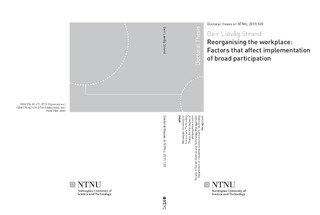| dc.contributor.author | Strand, Geir Liavåg | nb_NO |
| dc.date.accessioned | 2014-12-19T14:27:22Z | |
| dc.date.available | 2014-12-19T14:27:22Z | |
| dc.date.created | 2011-04-26 | nb_NO |
| dc.date.issued | 2011 | nb_NO |
| dc.identifier | 412665 | nb_NO |
| dc.identifier.isbn | 978-82-471-2778-0 | nb_NO |
| dc.identifier.uri | http://hdl.handle.net/11250/265802 | |
| dc.description.abstract | This research looks at how the workplace reorganises through implementing broad participation by employees. The companies under research had no prior experience utilising broad participation, and are located in an area where both the Labour Party and the Unions traditionally played a minor role compared to most other areas in Norway.
The foundation of this research is an action research project promoting broad participation in a group of companies over six years. For this dissertation, the degree of participation is “measured” by how much employees take part in the development processes and decision-making. “Broad participation” means that the employees to a high degree participate. In traditional Norwegian work life, the Industrial Relations System—the Trade Union (LO) and the Employers Confederation (NHO)—promotes broad participation at a national level; therefore, employee participation in decisionmaking is seen as good both by the LO and NHO. There are two forms of collaboration between LO and NHO. The first is conflict-based collaboration based on fight and is typically found in wage negotiations. The second is collaboration based on achieving mutual goals and is found in enterprise development projects. This latter form is defined as peaceful collaboration in this dissertation. In the actual companies, most of the employees are union members. The change project under study was organised by the local trade union (LO) and the local managers (NHO); one of the goals was to involve the employees in decision-making processes according to LO and NHO requirements. The employees also had no prior experience with broad participation.
In this dissertation, it is argued that enabling implementation of broad participation in companies depends on multiple factors:
Influence from the Industrial Relations SystemOrganisational historyManagement’s choice to allow employees to take part in decisionmakingThe union’s choice to accept an invitation to participate in decisionmakingExisting arenas for peaceful collaboration between management and employees
These five elements comprise my theoretical model, and five sub-questions were developed and mapped to each element. These attempts to answer the overall research question of what enables or hinders broad participation in companies. The subquestions are:
1. How has the Industrial Relations System influenced the change process?
2. How have organisational routines influenced the implementation of broad participation?
3. To what degree does management choose to allow union involvement in a company’s development work?
4. To what degree does the union choose to accept management’s invitation to take part in peaceful collaborative work?
5. How do the dialogues between management and unions operate at the arenas for peaceful collaboration?
It is argued that the answer for each of these five sub-questions answers the main research question on what enables or hinders implementation of broad participation in companies.
The results are presented as a case study using thick description and analysed with qualitative research methods according to the theoretical model and the above sub-questions. The data is comprised of reports and reflections from dialogue conferences and action plans from the change project, and supplemented by interviews with union leaders and managers, and my reflections from the process.
The first finding is that the local historical practise, where managers initially walked around the shop floor discussing issues, gave the employees a type of direct participation that influenced the organisational routines in the companies. This influence is still strong in the companies.
The main findings show that it is the same factors that enables and hinders implementation of broad participation. If the factor has a “positive value” it enables broad participation, while a “negative value” hinders broad participation. There is asymmetry in what enables or hinders broad participation. Management can enable or hinder broad participation; the unions can enable, but not hinder implementation of broad participation. If the unions try to hinder implementation, management can collaborate directly with each employee without involving the union. | nb_NO |
| dc.language | eng | nb_NO |
| dc.publisher | Norges teknisk-naturvitenskapelige universitet, Fakultet for samfunnsvitenskap og teknologiledelse, Institutt for industriell økonomi og teknologiledelse | nb_NO |
| dc.relation.ispartofseries | Doktoravhandlinger ved NTNU, 1503-8181; 2011:120 | nb_NO |
| dc.title | Reorganising the workplace:Factors that affect implementation of broad participation | nb_NO |
| dc.type | Doctoral thesis | nb_NO |
| dc.contributor.department | Norges teknisk-naturvitenskapelige universitet, Fakultet for samfunnsvitenskap og teknologiledelse, Institutt for industriell økonomi og teknologiledelse | nb_NO |
| dc.description.degree | PhD i industriell økonomi og teknologiledelse | nb_NO |
| dc.description.degree | PhD in Industrial Economics and Technology Management | en_GB |
